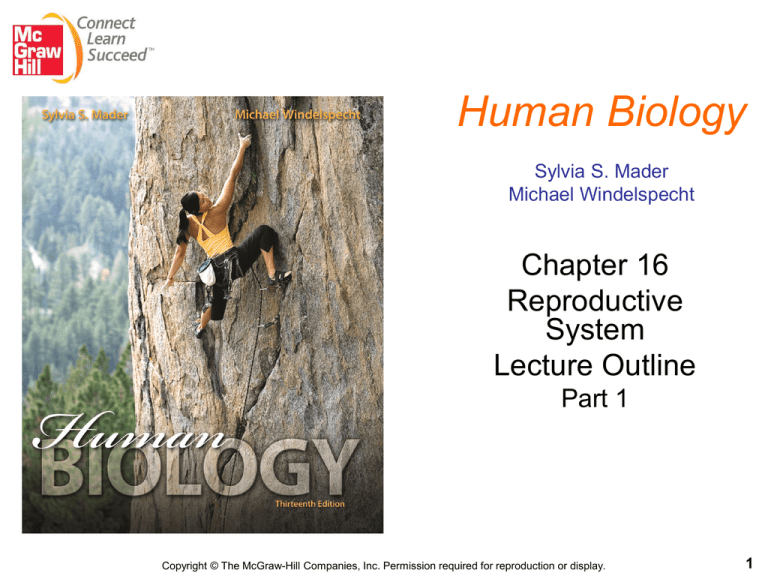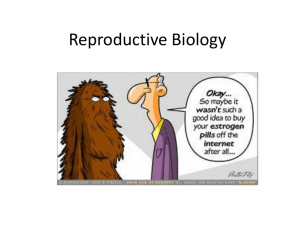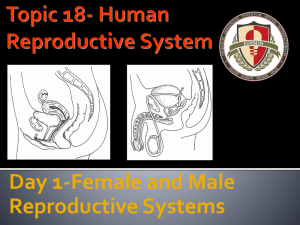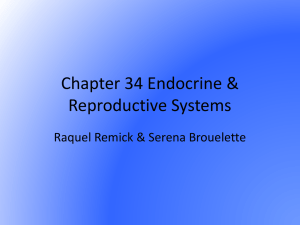
Human Biology
Sylvia S. Mader
Michael Windelspecht
Chapter 16
Reproductive
System
Lecture Outline
Part 1
Copyright © The McGraw-Hill Companies, Inc. Permission required for reproduction or display.
1
Reproductive System
2
Points to ponder
• What are mitosis and meiosis?
• How many chromosomes do body cells and sex
cells each have?
• Understand the anatomy of both the male and
female.
• Know the functions of each structure in the male
and female.
• What are the 3 parts of a sperm?
• How do hormones play a role in the male?
• Explain the ovarian and uterine cycles.
• Be able to discuss the levels of hormones during
the ovarian and uterine cycles.
• Where do fertilization and implantation occur?
3
Points to ponder
•
•
•
•
Be able to discuss common birth control methods.
What is infertility? What can cause this?
What are the options if a person is infertile?
Should we treat people who are infertile? Why or
why not?
• Understand genital warts, genital herpes, HIV,
hepatitis, chlamydia, gonorrhea, syphilis, bacterial
vaginosis, trichomoniasis, and candidiasis.
• Which STDs can be treated with antibiotics?
• Which birth control methods can help prevent
STDs?
4
16.1 Human Life Cycle
DNA in body and sex cells
• Body cells
– Each body cell has ___ chromosomes (23
pairs) within the nucleus.
– Cells that have pairs of chromosomes are
called diploid (2n).
5
16.1 Human Life Cycle
DNA in body and sex cells
• Sex cells
– _________ (egg and sperm) have only 23
chromosomes (1 of each pair) in their nuclei.
– Cells that have only 1 of each pair of
chromosomes are called haploid (n).
– During fertilization, a sperm and an egg
combine to form a zygote, and the
chromosome number is restored to the
diploid number of ____.
6
16.1 Human Life Cycle
Mitosis and meiosis
• Mitosis is
– a type of _________________ in which a cell
makes an exact copy of itself.
– a process used for growth and repair of
tissues.
– used by body cells (cells other than sex cells).
7
16.1 Human Life Cycle
Mitosis and meiosis
• Meiosis is
– a type of ________________ in which a cell
halves the number of chromosomes.
– a process used to form eggs and sperm.
– used by gametes (sex cells).
8
16.1 Human Life Cycle
The human life cycle
Copyright © The McGraw-Hill Companies, Inc. Permission required for reproduction or display.
MITOSIS
2n
2n
2n
MITOSIS
2n
zygote
2n = 46
diploid (2n)
MEIOSIS
haploid (n)
n = 23
FERTILIZATION
n
n
egg
sperm
Figure 16.1 The human life cycle.
9
16.2 Male Reproductive System
Male anatomy
1.Scrotum (1)
2.Testes (2)
3.Epididymides (2)
4.Vasa deferentia (2)
5.Urethra (1)
6.Three glands
7.Penis (1)
10
16.2 Male Reproductive System
Male anatomy
Copyright © The McGraw-Hill Companies, Inc. Permission required for reproduction or display.
urinary bladder
ureter (cut)
seminal vesicle
ejaculatory duct
pubic bone
prostate gland
vas deferens
bulbourethral gland
erectile tissue
of penis
ureter
urinary bladder
urethra
penis
seminal vesicle
anus
prostate gland
vas deferens
glans penis
foreskin
epididymis
bulbourethral
gland
testis
vas deferens
scrotum
urethra
Figure 16.2 The male reproductive system.
11
16.2 Male Reproductive System
Male anatomy: Scrotum and testes
•
________
– Sacs that hold the testes
– Help regulate the temperature of the testes
•
________
– Paired organs that produce sperm and male
sex hormones (made by interstitial cells)
– Composed of seminiferous tubules where
sperm are being produced
•
__________
– Sperm mature and are stored here
12
16.2 Male Reproductive System
Male anatomy: Scrotum and testes
Copyright © The McGraw-Hill Companies, Inc. Permission required for reproduction or display.
interstitial cells
Sertoli cell
vas deferens
epididymis
uncoiled
seminiferous
tubule
Seminiferous tubules
100 µm
lobule
testis
scrotal sac
Testis
(cut to show lobules)
© Ed Reschke
Figure 16.4a-b Spermatogenesis produces sperm cells.
13
16.2 Male Reproductive System
Sperm production
•
Sperm are produced within the seminiferous
tubules of the testes.
•
__________ cells help nourish sperm and
regulate the process of sperm production
(spermatogenesis).
•
Sperm (spermatozoa) are stored and mature
in the ____________.
14
16.2 Male Reproductive System
Sperm anatomy
•
3 parts
– The head is covered by a
cap called the _________
which stores enzymes
needed to penetrate the
egg.
– The middle piece contains
mitochondria to make
ATP.
– The tail provides
______________ for the
sperm.
Copyright © The McGraw-Hill Companies, Inc. Permission required for reproduction or display.
acrosome
head
middle piece
tail
end piece
d. Sperm cell
Figure 16.4d Spermatogenesis produces sperm cells.
15
16.2 Male Reproductive System
Male anatomy: Vas deferens
and urethra
•
Vas deferens
– Transports sperm to the __________
•
Urethra
– Transports sperm out of the body
16
16.2 Male Reproductive System
Male anatomy: 3 glands that
contribute to semen
•
______________ – produce a sugary fluid that
provides energy for the sperm
•
________ gland – produces an alkaline fluid to
help buffer the acidic pH of the vagina
•
________________ glands – produce mucus
that acts as a lubricant
17








